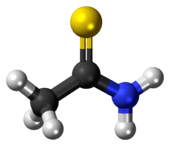Thioacetamide
 | |
 | |
| Names | |
|---|---|
| IUPAC name
Thioacetamide | |
| Preferred IUPAC name
Ethanethioamide | |
| Other names
acetothioamide, TAA, thioacetimidic acid, TA, TAM | |
| Identifiers | |
3D model (JSmol) |
|
| ChEBI | |
| ChEMBL | |
| ChemSpider | |
| ECHA InfoCard | 100.000.493 |
| KEGG | |
PubChem CID |
|
| RTECS number | AC8925000 |
| UNII | |
| |
| |
| Properties | |
| C2H5NS | |
| Molar mass | 75.13 g/mol |
| Appearance | colourless crystals |
| Odor | slight mercaptan |
| Density | 1.269 g/cm3 |
| Melting point | 115 °C (239 °F; 388 K) |
| Boiling point | decomposes |
| good | |
| -42.45·10−6 cm3/mol | |
| Structure | |
| monoclinic | |
| Hazards | |
| Main hazards | Foul stench, carcinogenic |
| Safety data sheet | MSDS |
| R-phrases (outdated) | R22, R36, R37, R45 |
| S-phrases (outdated) | S45, S53 |
| Related compounds | |
Related compounds |
acetamide, dithioacetic acid |
Except where otherwise noted, data are given for materials in their standard state (at 25 °C [77 °F], 100 kPa). | |
| Infobox references | |
Thioacetamide is an organosulfur compound with the formula C2H5NS. This white crystalline solid is soluble in water and serves as a source of sulfide ions in the synthesis of organic and inorganic compounds. It is a prototypical thioamide.
Coordination chemistry
Thioacetamide is widely used in classical qualitative inorganic analysis as an in situ source for sulfide ions. Thus, treatment of aqueous solutions of many metal cations to a solution of thioacetamide affords the corresponding metal sulfide:
- M2+ + CH3C(S)NH2 + H2O → MS + CH3C(O)NH2 + 2 H+ (M = Ni, Pb, Cd, Hg)
Related precipitations occur for sources of soft trivalent cations (As3+, Sb3+, Bi3+) and monovalent cations (Ag+, Cu+).
Preparation
Thioacetamide is prepared by treating acetamide with phosphorus pentasulfide as shown in the following idealized reaction:[1]
- CH3C(O)NH2 + 1/4 P4S10 → CH3C(S)NH2 + 1/4 P4S6O4
Structure
The C2NH2S portion of the molecule is planar; the C-S and C-N distances are 1.713 and 1.324 Å, both indicating multiple bonding.[2]
Safety
Thioacetamide is carcinogen class 2B.
It is known to produce marked hepatotoxicity in exposed animals. Toxicity values are 301 mg/kg in rats (LD50, oral administration), 300 mg/kg in mice (LD50, intraperitoneal administration).[3] This is evidenced by enzymatic changes, which include elevation in the levels of serum alanine transaminase, aspartate transaminase and aspartic acid.[4]
References
- ↑ Schwarz, G. (1945). "2,4-Dimethylthiazole". Organic Syntheses. 25: 35. ; Collective Volume, 3, p. 332
- ↑ Truter, M. R. (1960). "An accurate determination of the crystal structure of thioacetamide". Journal of the Chemical Society. 1960: 997–1007. doi:10.1039/JR9600000997.
- ↑ "HSDB: THIOACETAMIDE CASRN: 62-55-5". Hazardous Substances Data Bank.
- ↑ Ali, S.; Ansari, K. A.; Jafry, M. A.; Kabeer, H.; Diwakar, G. (2000). "Nardostachys jatamansi protects against liver damage induced by thioacetamide in rats". Journal of Ethnopharmacology. 71 (3): 359–363. doi:10.1016/S0378-8741(99)00153-1.
- "Thioacetamide (Sulfo amine)". Chemical Land 21. Retrieved February 14, 2006.